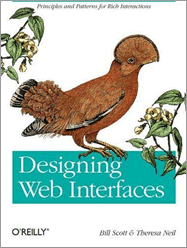 Bill Scott and Theresa Neil's excellent book, Designing Web Interfaces, was recently released.
Bill Scott and Theresa Neil's excellent book, Designing Web Interfaces, was recently released.
The book outlines 75 patterns for designing rich interactions on the Web with detailed descriptions of the advantages and disadvantages of each solution. It's a fantastic compendium of what makes interaction design work on the Web. I had the pleasure of writing the book's foreword, which the authors allowed me to share here.
Foreword by Luke Wroblewski
In architecture, parti refers to the underlying concept of a building . Will it be an academic structure aimed at increasing cross-disciplinary collaboration or a theater flexible enough to support quick set changes? To bring a specific parti to life, architects must not only define its essence but also know how to manage the huge number of considerations that ultimately impact its construction.
Design principles are the guiding light for any architect’s parti. They define and communicate the key characteristics of a building to a wide variety of stakeholders including clients, builders, city planners, and engineers. Design principles articulate the fundamental goals that all decisions can be measured against and thereby keep the pieces of a project moving toward an integrated whole. But design principles are not enough.
Every aspect of a building from an attic to a Zen garden has a set of opportunities and limitations that can either add to or detract from the main concept or parti. These include standard dimensions, spacing requirements, aesthetics, physical limitations, and more. Architects who want to bring coherent visions to life need to learn the detailed ins and outs of these design considerations so they can select the best solutions from the options available.
This combination of design principles at the top and design considerations at the bottom is what allows architects to fill in the middle with meaningful buildings that enable people and organizations to interact, communicate, and get things done.
Those of us whose parti is bringing rich web applications to life can also benefit from a framework of design principles and considerations to guide us. In these pages, Bill Scott & Theresa Neil give us just that. Through 30 years of designing and developing software, Bill and Theresa have been consummate taxonomists —naming, documenting, and sharing in loving detail what makes rich interactions succeed and fail.
The breadth of solutions they’ve encountered have given Bill and Theresa a unique perspective on the design principles behind the most successful rich interactions on the Web. From “make it direct” to “react immediately,” the principles they outlines in this book are your yardstick for measuring the value that rich interactions bring to your web application. Through in-depth descriptions of context and trade-offs, Bill and Theresa support each principle with the design considerations and best practices you need to make informed decisions. Engineers, product managers, marketers, and designers can rally around and continually return to these principles and considerations to ensure that everyone is evaluating the impact of design decisions the same way.
This combination of rich Web interaction design principles at the top and design considerations at the bottom allows web designers to fill in the middle with meaningful structures that enable people and organizations to interact, communicate, and get things done. Just like our friends, the architects. So dive in and immerse yourself in the direction and details you need to bring your rich web application partis to life!
Luke Wroblewski, October 2008
More about Designing Web Interfaces